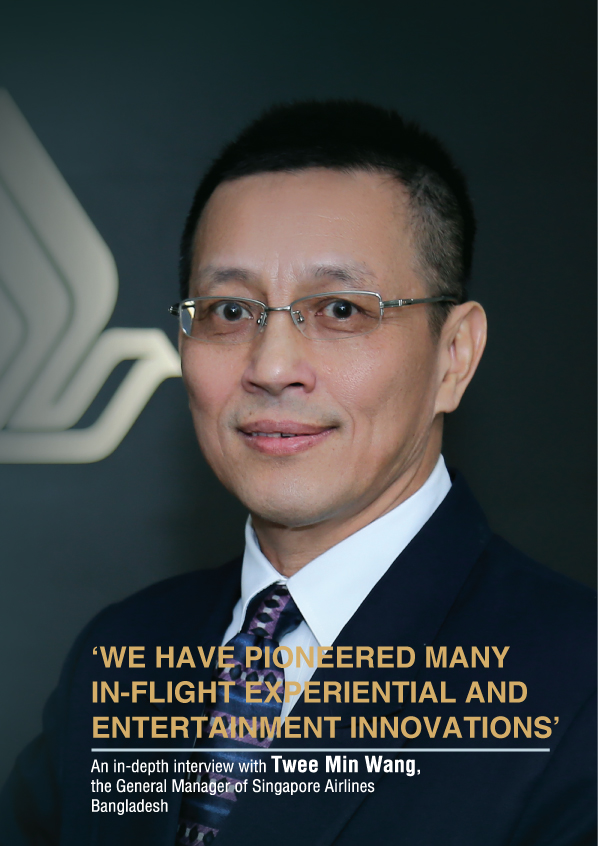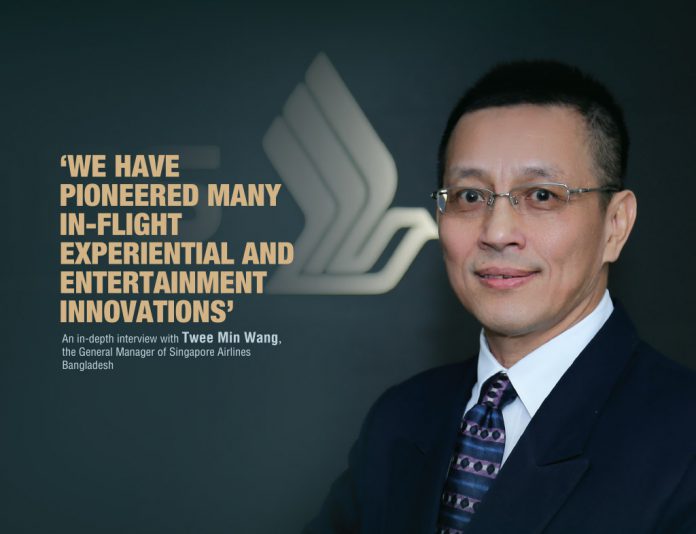
Twee Min Wang is a career veteran with the Singapore Airlines. He has spent around 35 years with the career. Started with the airlines as an IT specialist in 1982, Wang spent the first 10 years with the airlines in different IT projects. Later on, he had worked in nine different countries with the Airlines. Before moving to Bangladesh as its General Manager, Wang had worked in Sao Paolo in Brazil, Tokyo in Japan, Hong-Kong, Sendai in Japan, Durban in South Africa, Surabaya in Indonesia, Nagoya in Japan and Barcelona in Spain.
Decked in a gray suit, Twee Min Wang, the General Manager of Singapore Airlines in Bangladesh greeted me with customary oriental benevolence when I reached at his office in Gulshan.

The glass walled office at the top floor of a Gulshan Avenue building had a chic décor. It reflected the brand image of Singapore Airlines-which consistently has been one of the most profitable airlines globally, and has always had the reputation of a trendsetter and industry challenger.
I was there to shoot questions to him to find out what makes Singapore Airlines the best airline in the world and in Mr Wang, I found an able C-Suit communicator, who didn’t shy away from answering all of my queries.
Here is the excerpt of that interview for our readers of Fintech
FINTECH: Can you tell us something about your career? When did it start?
T.M Wang: I started my career with SIA in 1982 and spent 10 years in the IT division. My first overseas posting was to Tokyo in a technical position. After that I was rotated into the Sales and Marketing division with postings to Hong-Kong, Sendai (Japan), D Durban (South Africa), Surabaya (Indonesia), Nagoya (Japan) and Barcelona (Spain). After Barcelona, I returned to head office, Commercial Supplies department (CSD) and oversaw the Purchasing and Logistics section. CSD is the department responsible for the purchase of all the items that passengers uses on-board a Singapore Airlines flight.
At CSD, we source and purchase the finest items from around the world. We go to great lengths to acquire the items, so that our customers can experience the very best, when they fly with Singapore Airlines. We invest a lot of time and effort to ensure that the SIA product is the best experience for our customers.
After five years in Singapore, I moved to Sao Paolo as General Manager Brazil until November 2016 when I was assigned to Dhaka. This is my sixteenth job in the company over the last 35 years and Dhaka is my ninth overseas posting.
SIA has been operating to Dhaka for over 30 years and we currently offer 10 flights a week to Singapore, with a daily departure at 23:55 pm and a 2nd flight on Sundays, Wednesdays and Thursdays departing Dhaka at 13:25 pm.
FINTECH: What is the longest non-stop flight of Singapore Airlines now?
 T.M Wang: Singapore-San Francisco is currently the longest non-stop Singapore Airlines flight. The flight time is between 15 hours and 15 minutes (Singapore – San Francisco) and 16 hours and 30 minutes on the return flight due to the head winds. Passengers from Dhaka have an excellent connection to the San Francisco flights which depart Singapore at 09:25 am and arriving in San Francisco at 09:40 am on the same morning. The early morning arrival also allows passengers to connect to other USA destinations. Return flights from San Francisco departs at 11:30 am and arrives in Singapore at 19:00 pm and connects SQ446 to Dhaka at 20:35 pm.
T.M Wang: Singapore-San Francisco is currently the longest non-stop Singapore Airlines flight. The flight time is between 15 hours and 15 minutes (Singapore – San Francisco) and 16 hours and 30 minutes on the return flight due to the head winds. Passengers from Dhaka have an excellent connection to the San Francisco flights which depart Singapore at 09:25 am and arriving in San Francisco at 09:40 am on the same morning. The early morning arrival also allows passengers to connect to other USA destinations. Return flights from San Francisco departs at 11:30 am and arrives in Singapore at 19:00 pm and connects SQ446 to Dhaka at 20:35 pm.
Next year, SIA will re-instate the Singapore-New York flight, and this will be a 19 hours flight, which will become the longest non-stop flight by any airlines.
FINTECH: I have read it somewhere that for an airline, the profit per flight is better in shorter distance than in longer distance. Is it true? If, why so?
T.M Wang: Profitability varies from one airline to another, and is dependent on the fares that are sold and the cost of operations. Generally the cost of long haul operations is higher due to the amount of fuel burnt and inflight services provided. For example, for the 19 plus hour direct flights from Singapore to New York, the aircraft had a limited passenger seating capacity, and it had to carry more fuel to fly the distance. There would be 3 main meals and snacks served, which adds to the cost of operations.
FINTECH: Throughout the history, Singapore Airlines is always at the forefront of adapting the new technology. For example, it is the first airline to start operating the Airbus-A380, the largest passenger airliner in the world. Why do airlines opt for this new technology and innovation?

T.M Wang: Singapore Airlines operates on three key pillars, which are Service Excellence, Product Leadership and Network Connectivity. We learned over the years that our customers prefer to fly in new aircraft and experience the latest inflight technologies. As such, we are constantly engaging aircraft manufacturers to improve designs and comfort for our customers.
For example, in October 2006, SIA introduced the world’s widest First and Business Class seats which transformed into fully-flat beds. This particular innovation took the world by storm and transformed comfort in air travel.
SIA has a total of 108 aircraft in its fleet of all wide-body jets comprising the Airbus A380, A350-900, A330-300, and a range of Boeing 777-200, 777-300. As of 01 July 2017, the SIA fleet has an average age is seven years and seven months, and 126 new aircraft on order, including 5 Airbus 380, 52 Airbus 350-900, 20 Boeing 777-9 and 49 Boeing 787-10. These aircraft orders will be delivered over the next few years, starting with the arrival of a new Airbus A380 later this year. With new aircraft orders, we have the opportunity to introduce new seat and designs to delight our customers. Watch this space for more news.
FINTECH: What about the network connectivity of Singapore Airlines?
T.M Wang: SIA and Silk Air currently operates to over 130 destinations in over 30 countries giving our customers multiple options to travel to visit friends and explore the world. For example, SIA has nine daily flights to Jakarta, eight flights a day to Hong-Kong, six daily flights to Bangkok, four flights a day to London, two daily flights each to San Francisco and Los Angeles, and daily flights to the major European destinations. With multiple flights to a single destination, passengers can choose the option which best suit their schedule.
FINTECH: I think people wouldn’t mind spending time in the Changi Airport as it is frequently ranked as the best airport in the world….
T.M Wang: Yes, we are proud of the facilities at Changi Airport. Many of Changi’s best innovations are small but considerate, such as lockable mobile phone charging stations, free foot-massage machines (socks on, please) on every concourse. Additionally, Changi is also well-equipped for napping – a precious commodity for a connecting passenger. All three terminals have dedicated snooze areas, where travelers can stretch out on sleeper chairs for as long as they like.
FINTECH: Can you talk about the service excellence of Singapore Airlines. It is the trait that makes Singapore Airlines the best airlines in the world. Isn’t it?
 T.M Wang: Service excellence is one of our key pillars. SIA has comprehensive training programs to instill the necessary service skills for all ground staff.
T.M Wang: Service excellence is one of our key pillars. SIA has comprehensive training programs to instill the necessary service skills for all ground staff.
The SIA cabin crew in particular, undergo a very rigorous four-month training program where they acquire the finer skills required for flight safety and inflight service.
Over the years, SIA pioneered a number of in-flight experiential and entertainment innovations. SIA was the first international airline to introduce free alcoholic and non-alcoholic beverages, and free head phones. We also offer ‘Book the Cook’, where First and Business class passengers can choose their favorite gourmet main course from a tantalizing selection of dishes designed by Singapore Airlines’ International Culinary Panel before their flight.
The company continues to innovate to improve services on board and deliver the best-in-class flying experience. Our menus are also specially created to reflect culinary influences and preferences of the regions we flies to. In Singapore, we use a pressurized tasting room to taste test the meals simulating taste at an elevation of 30,000 feet as cabin pressure changes can

affect our taste buds. We have a panel of International Culinary chefs from around the world to design and assist in the preparation of in-flight meals. We also make it a point to serve up regional favorites ranging from Randy’s Donuts in Los Angeles to Blue Bell Ice Cream in Houston on flights originating from those cities.
We also have a panel of three Wine Masters, who help to select the various wines that are served on board our flights. They also provide advice on the art of food and wine pairing.
FINTECH: Can you tell us something about the iconic Singapore Girl?
T.M Wang: Created in 1972, the Singapore girl is one of the airline’s most recognized figures. In her distinctive Sarong Kebaya, designed by French haute-couture designer Pierre Balmain, she epitomises Singapore Airlines tradition of friendly service and Asianhospitality. ■








